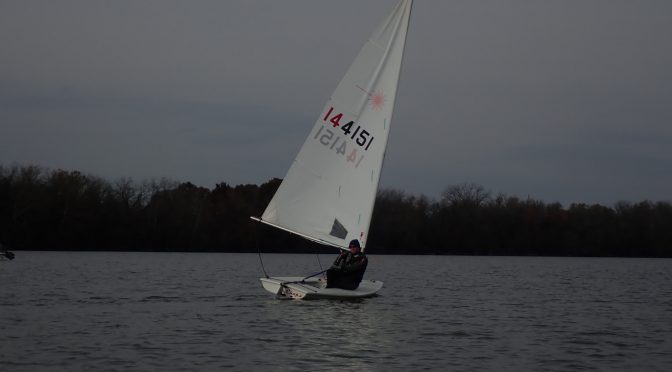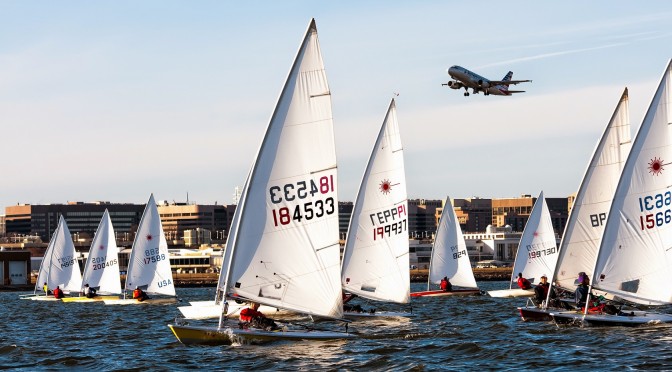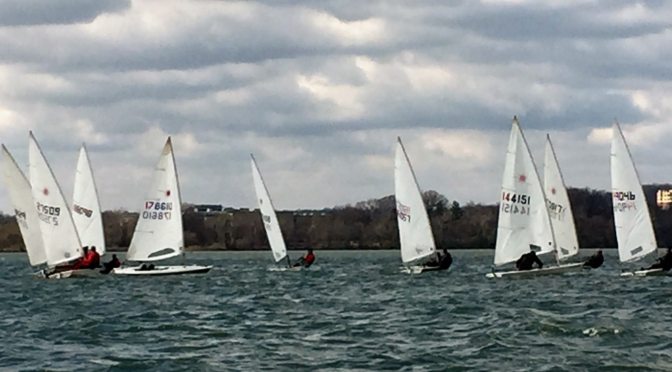Category Archives: Fleets
PRSA Fleets
2017-2018 Laser Frostbite Series #17 – 3/18/18
Thanks to Tom Hutton who gave up a day of sailing on a sunny day to give us the opportunity to race on the last day the frostbite season. The NNW to NNE light to nearly non-existent breeze and a strong ebb tide made for challenging starts and windward legs on the four one lap and one two lap races.
Capital City Laser Regatta: March 24 & 25, 2018
It’s around the corner. The daffodils are out. The cherry trees are ready to explode. Plan to sail your Laser! On Saturday after racing we’ll have a BBQ/picnic and trade stories and plans for the season which is well worth the $20 registration fee.
NOR, registration, who’s coming, sailing instructions and more.
That link, results from past years, and Tom’s email if you have questions.
2017-2018 Laser Frostbite Series #16 – 3/11/18
Today we had light turnout and light shifty wind. For those that chose not to come, I think it was the wrong decision. It was a super nice day with temps around 50 and abundent sunshine. The wind ended up coming from every direction and was mostly between 1 and 5. Jim and Melissa did an excellent job running the races and changed the course 3 times to try and account for the shifts. It ended up playing out that 3 of the 5 races were reaching races. The other two started of with the wind coming from the windward mark but shifting during the race. I found with the light air, it was helpful to sit on top of the dagger board most of the day. Also starting well was helpful. While my position was fine for the starts, the people that came to the line with speed tended to be the ones in front. Something that is important to remember the when the start line is parallel to the wind with the pin to windward is that starting at the pin can get you pinched out by the leeward boats that can head you up.
2017-2018 Laser Frostbite Series #14 – 2/25/18
The race committee (thanks Nabeel and Francisco) smartly kept the marks in place for the second race but renamed the marks from leeward to windward, and windward to leeward, so you might call that a shifty day. In the second race i started on port on the right end of the line while the fleet sailed on starboard on the left end of the line, and in a very light wind once around the course, maintained a lead and won. On such a light shifty day the key for me to keeping the boat moving was watching the windward boats for indications of possible shifts, and sometimes powering up by bearing off on short term headers instead of tacking.
2017-2018 Laser Frostbite Series #13 – 218/18
Today the wind was rather shifty and it picked up and died down a lot. For me it was pretty challenging to tack in the wind shifts as the occurred mostly in the lighter wind. I feel that the most important aspect to keep in mind on a day like today would be to have clean air to keep your speed. Before going out I thought there was going to be a lot of wind, but most of it died down before the first race. I placed third in the first few races, which I think is mainly because I tacked out of dirty wind and I was able to somewhat control the wind shifts. In the last race however, and I’m pretty sure many can relate, the wind was way to light and I had difficulties getting off the start line. I can’t recall what sides were favored in which races, because it was so shifty, but I feel that in general the left side was favored to most people. In the last race when the wind died down, the course was a reach in both directions, which I actually liked as we didn’t have to adjust to shifts as much. I had a lot of fun on the water and the races were pretty competitive.
Additional Thoughts:
2017-2018 Laser Frostbite Series #4 – 12/10/17
Thanks for John Van Voorhis and Cliff Bartlett for doing the RC today and working diligently to square the line and give us a nice mix of Olympic and WL courses and they even used the flags!! 🙂 Also a big thanks to John for offering to help me launch and retrieve the 19’ boat when I had RC last week.
I hope no one reading this is hoping for a lot of technical insight as to shifts, persistent or otherwise, I’m pretty sure I would not know one from the other. Overall my mantra is to slog it out as best I can, keep the boat flat and hike as much as my body will allow me, and of course try not to make any mistakes or cut things too close.
This is the best I know:
Starts:
First, I benefited greatly from having ½ the fleet coming late to the start of race 1. That gave me a big boost in the day’s score. Being on time paid off for me.
When the start line is square (as it was in most races today), I find I sometimes do better coming in on port and searching for a hole about 15-30 seconds from the start. You have to be really quick though with your tack, because there is little time and space between the starboard tackers. So it’s a little risky. In one case, however, it really paid off because I was able to stay on port by threading the needle as they say, and in that particular race ( I forget which one) a port tack was favored. In that last few seconds before the start you really do need to head down off the wind and power up, and accelerate so that you are up at full speed when the gun goes off. That seems to be the only way to have a good race. So if you are going to concentrate and be on your game, these first 10 or 20 seconds after the gun goes off are the most critical.
Upwind:
I had my cunningham very tight, outhaul about 2” off the boom at mid point, and the vang ¾ on. The tight cunningham helped me when the puffs came so as to not be overpowered. I pretty much tried not to sail out to the lay lines too much as a shift in wind could easily gain you several boats if you tack quick enough on the header. As it was very quirky and puffy, I did my best to ‘ease-hike-trim’ whenever I could, and a few times I could really feel it working, and I was gaining on other boats. As for when I would tack, that pretty much was determined by my looking at the luff of my sail, and when it started to collapse in (ie a header), I would throw in a tack.
Reach:
On the reaches, I would pull my board up ½ and ease the cunningham off all the way and then adjust the vang to as to get the best sail shape I could get. My cunningham does not seem to come off unless I go to the mast and pull on the slack of the line, so I found myself doing that a lot today.
Downwind:
Cunningham all the way off, board up 1/2 , outhaul about 2” off the boom at mid point, and the vang adjusted until I saw a good sail shape, which oddly, meant putting on quite a bit of vang. I was worried about death rolling in the puffs, and managed to stay flat by looking back all the time for the darkness in the water, and then when it hit, I would use aggressive mainsheet trimming to dampen out the oscillations. But when the wind comes from the west like that, it can cause a lot of deathrolling. So on days when it’s windier, if I feel I might deathroll, I quickly sail off on a reach and pop up on a plane and do the best I can that way. Better to be up on a plane, sail a little longer, and then gybe when you feel in control (or even chicken-tack if it’s really windy). Nothing is slower than going for an unwanted swim.
One final thought, it pays to look up at your sail shape as often as you can. I am doing this now more than I used to in the past ( I think Len mentioned that once or twice to me). So in going downwind, again for some reason it seemed like I had to put on vang for a nice shape, and I know most people ease their vangs going downwind, so I don’t quite know what caused that. Maybe it’s the new sail that has not yet broken in.
Best,
Jim Klein
2017-2018 Laser Frostbite Series #2 11/26/2017
This was the first racing of the 2017-2018 Laser Frostbite series. It is traditional for the sailor who finished 3rd to do a write up of the weekend. I have no intention of deviating from this tradition, however, we don’t have the contact info on the sailor that got 3rd and my 4th isn’t that far off. Next week we’ll get to the 3rd place finisher faster to let them know about their finish and duty.
The weather cooperated and was at the higher end of the fun scale, 8 to 10 with gusts at 15 to 18 blowing from the northeast. RC set a good Olympic course and got a whopping 6 races in with 20 sailors turning out. The wind slowly dwindled as the afternoon went on so the first races were all speed and hiking then the later races were searches for the big gust to keep speed up.
My first 2 starts were my best and I worked the left side of the course. Not really for any strategic reason but in higher winds I’m looking to minimize tacks as those sometimes go poorly for me. I think the left side of the course had more wind all day so this generally helped me being on that side of the course. I didn’t have any issues at the marks so these finishes were solid.
The third race saw my best and worst start. I had a great boat end start that got cancelled due to a general recall. The second attempt I botched by getting into irons on the wrong side of the committee boat. I ended up playing catchup with some pretty successful upwind legs as well as a windward mark rounding that paid off. In a big crowd I try to remember that over standing is better than getting close. Lots of boats make bad air and in the past I’ve sat barely fetching the mark with other boats sail around me. Not today! I got to be the boat sailing around others
The last 3 races saw lower wind and some second row starts. My plan with a second row start is to work to clear air then get on the right tack ASAP. Second rule with a second row start the laylines are off limits; boat ahead will tack on them and you’ll have to eat their bad air. In the last race I spent a little time on the right side of the course thinking I had the lifted tack. I got to watch the smarter folks go fast in the more regular puffs that came down the left side of the course.
Overall the day was very fun and I was only a little sore. 20 sailors turning out over thanksgiving weekend is encouraging. We had some new faces which are great to see out! I’m sure the rest of the fleet will welcome them as we see them out racing more. See everyone next week!
Tom Hutton
2017-2018 Laser Frostbite Sailing Has Started!
Our Laser frostbite season has started! We race on Sundays on the Potomac River from November 18 to March 24, and we wrap up our season with the Capital City Regatta on March 30-31. Skippers meeting is at 12PM with the first start at 12:30PM. No races are started after 3:30PM. Come out and join us!
While the fleet welcomes out-of-town guests, we ask in-town skippers to join PRSA (see the membership application). Contact Laser Fleet Captain Tom Hutton with questions.
2016/2017 Laser Frostbite Series #16 – 3/19/17
Sunday March 19, 2017. Good weather for the last day of frostbiting. It was sunny but cool with winds in the 10-15 mph range from the northwest. We got in 5 races, all olympic course, and I did well in all but the last one.
My general start tactic on a heavier wind day is what I think of as a drift start. I hang out past the committee boat on the right side of the course. With about 30 second to go I power up and head for somewhere on the line. When a bunch of boats bunch up at the committee boat there is enough wind to get to leeward of them and make it to the line on time. If the boat end folks are early they will head down the line and leave a nice window. This worked well today on most races and I was competitive to the windward mark.
On the course I used my normal heavy wind tactics namely, tight vang, medium outhaul and Cunningham, then lots of hiking. I ease my outhaul 100% at the windward mark to give more power downwind and I ease the vang to about 50%. The eased vang I find (and have heard) helps to bear away. The triangle legs of the olympic were great and I think I reached a plane on most downwind legs. This is super fun and I was able to make up some ground if I caught a puff.
I did have issues keeping my mainsheet running clean. I had a few issues on the course because of this. Twice I had the sheet wrapped around a foot causing me to tack rather than duck a starboard boat. I also had a serious knot at one of the windward roundings that I had to undo before I could bear away. Mainsheet discipline will be something for me to work on for windier days. Still a fun last day, I’m looking forward to Cap City next week!



